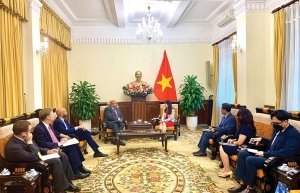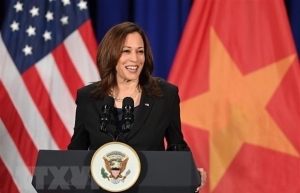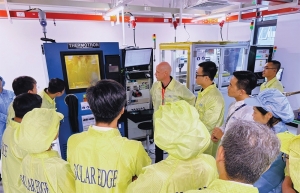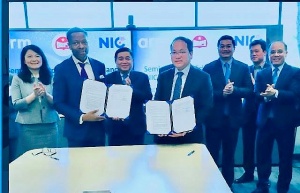Vietnam well-positioned for US groups
How do you assess the importance of the upgraded Comprehensive Strategic Partnership that the two countries have gained nearly a year in?
We and our members commend the governments of Vietnam and the US for signing the Comprehensive Strategic Partnership (CSP). This agreement aligns seamlessly with our mission to foster closer ties and promote trade and investment between the two countries, representing a significant step forward. Our chamber is poised to support both governments and our members in advancing this partnership.
 |
| Winnie Wong, vice chairwoman of the American Chamber of Commerce in Ho Chi Minh City |
Over the past 30 years, trade, investment, and economic growth have been the cornerstones of the robust bilateral relationship between Vietnam and the United States. The CSP further strengthens this foundation by committing both countries to continue opening their markets and addressing trade and investment issues within an agreed framework. This commitment provides businesses and investors with greater confidence in the potential of both markets.
Another crucial aspect of the CSP is the United States’ commitment to supporting the development of physical and digital infrastructure, energy, and sustainable agriculture in Vietnam. These sectors are pivotal for Vietnam’s growth and development, presenting significant opportunities for our members. Progress in these areas, facilitated by US support, will undoubtedly drive growth and investment, thereby boosting economic activity across multiple sectors.
The CSP also highlights Vietnam’s potential as a major player in the semiconductor industry. The Vietnamese government has prioritised this sector and recognises the need for substantial foreign investment and support. The partnership includes commitments from both countries to enhance cooperation in innovation and the development of a high-tech workforce. With strong and growing interest from global investors, we anticipate significant expansion in this sector in the coming years.
Additionally, the CSP promotes collaboration in various other sectors, including climate, defence, tourism, and education.
Could you analyse the recent wave of new investment flows from the US into Vietnam?
We have observed a series of significant investments by US-based firms in the high-technology sector in recent months. Notably, Amkor Technology recently inaugurated its largest chip factory in northern Vietnam with an investment of $1.6 billion.
Other prominent US firms in the semiconductor industry, such as Lam Research and Marvell, have also announced plans to invest in semiconductor manufacturing and expand their development footprint in the country. During recent visits to Vietnam, executives from Nvidia and Apple also expressed interest in Vietnam, highlighting the country’s potential in this critical sector.
US investors are also turning their attention to Vietnam’s energy industry. Our member, AES, recently received approval for its Son My liquefied natural gas terminal, a joint venture with PetroVietnam representing an investment of $1.4 billion. This follows the approval of the supplemental Son My II combined cycle gas turbine project last year, with an estimated investment of $1.8 billion.
In the food and beverage sector, Suntory PepsiCo, another of our members, has commenced construction on a new beverage factory in Vietnam – the largest and most modern in the Asia-Pacific – representing a $300 million investment. This marks the largest investment the company has made in Vietnam and is its sixth factory in the country.
Similarly, Coca-Cola is building its fourth factory in the south of Vietnam, with a capacity of one billion litres per year and an investment of $136 million.
In the manufacturing sector, Techtronic Tools announced plans earlier this year to invest up to $650 million in building manufacturing and research and development facilities in one of Ho Chi Minh City’s industrial parks.
This year’s US-ASEAN Business Council delegation to Vietnam was the largest on record, with leaders of over fifty companies across multiple industries. Additionally, recent investments in Vietnam’s consumer retail and healthcare sectors by US firms such as Bain Capital and Warburg Pincus underscore the country’s increasing attractiveness.
What opportunities are there for aviation, AI, digital economy, creative economy, and green energy transition in the future?
US investor interest in Vietnam covers a broad range of industries. This underscores the ample potential investors see in the country.
We are encouraged by the Vietnamese government’s recent decree on direct power purchases. As one of our main advocacy priorities in the last few months, we believe it is an important step in advancing the country’s transition to green energy. The fact that it clarifies an important aspect of energy production and purchasing will help boost investments in the renewable energy sector.
Vietnam is also well-positioned to take advantage of opportunities in AI. Earlier this year, local IT giant FPT announced a $200 million investment in this space with Nvidia, as part of a long-term partnership to develop AI capabilities. Other Vietnamese players in technology are actively researching and developing AI applications, representing major opportunities for investors, while global technology giants like Meta are rolling out AI tools and services to the Vietnamese market.
The aviation industry is another sector in which we observe opportunities. Vietnam’s growing and dynamic aviation market has prompted airlines to boost investments in capacity. As a result, Vietnam Airlines recently announced new aeroplane deliveries from our member Boeing in the coming months, as part of a broader order.
On the production front, Boeing also announced earlier this year that it would increase the manufacturing of components in Vietnam via one of its key suppliers.
To engage high-quality investors from the United States, what factors should Vietnam and the US keep in mind?
We identify five factors essential to attracting US investors to Vietnam. The most important factor, which has driven the country’s remarkable economic performance in recent years, is the stability of government policies. Such stability is a critical foundation for an attractive investment environment, as businesses consistently favour clear and consistent regulations that support business operations and growth.
A second factor is Vietnam’s positive economic track record and its anticipated growth trajectory. The Vietnamese economy demonstrated significant resilience in recovering from the pandemic, returning to a growth path despite a challenging global context. We commend the government for its openness to input from key stakeholders, including ourselves and other business associations, in shaping the country’s future development agenda.
A third key factor positioning Vietnam favourably over other countries is its competitive and educated labour force. This is particularly decisive for manufacturing businesses and has given Vietnam an edge over countries like China, Thailand, Malaysia, and Indonesia. The skilled labour force has been instrumental in establishing Vietnam’s central role in global supply chains across various industries.
Vietnam’s favourable demographic trends further enhance its attractiveness. The country’s young, urban, and educated population is eager to join the workforce and market economy, making it an appealing market for businesses across industries. With rising per capita income and increasing disposable income, more companies are likely to seek a larger share of the Vietnamese market.
Finally, the potential for enhanced cooperation in trade, investment, technology, innovation, and education between Vietnam and the United States under the CSP significantly bolsters the attractiveness of Vietnam as an investment destination.
What is your prediction for the development of the investment wave from the United States going forward?
In the next few years, we anticipate robust and sustained investment from US businesses in Vietnam, driven by policy stability, economic resilience, a skilled labour force, favourable demographics, and strategic bilateral cooperation.
This trend will enhance Vietnam’s economic landscape and reinforce its position as a leading investment destination in the region.
 | Building US-Vietnam ties via trade As the United States and Vietnam will approach the 10-year anniversary of the Comprehensive Partnership, it is an exciting time for our bilateral relationship and the United States’ engagement with the broader Southeast Asia region. |
 | Thriving trade setting up high-level visit from US With their investment and trade blossoming, Vietnam and the United States are expected to soon see a high-level visit from the latter to the former, which is hoped to lay firm groundwork for both nations to elevate their existing ties to a greater level next year. |
 | Bilateral trade boon felt with United States A comprehensive strategic partnership has helped expand bilateral trade between the United States and Vietnam, with the former gradually removing technical barriers for the latter’s exports. |
 | Vietnam looking for innovation cooperation opportunities in the United States Vietnamese Minister of Planning and Investment Nguyen Chi Dung held meetings with members of the Vietnam Innovation Network and technology giants in Silicon Valley (San Francisco) during a business trip to the United States during June 22-26. |
 | Comprehensive partnership pushes US trade prospects As the United States prepares to celebrate 248 years of independence, US Ambassador to Vietnam Marc E. Knapper finds similar cause to celebrate the upcoming first anniversary of its Comprehensive Strategic Partnership with Vietnam. |
What the stars mean:
★ Poor ★ ★ Promising ★★★ Good ★★★★ Very good ★★★★★ Exceptional
Related Contents
Latest News
More News
- Government moves to establish International Financial Centre (December 21, 2025 | 21:00)
- Vietnam's IFC to target global investment flows (December 21, 2025 | 18:00)
- Two national hospitals expand capacity with new facilities (December 20, 2025 | 09:00)
- Ha Tinh breaks ground on major Vingroup industrial and energy projects (December 19, 2025 | 18:24)
- EVN launches major power infrastructure projects nationwide (December 19, 2025 | 18:17)
- VAL inaugurates second production line to meet domestic animal feed demand (December 19, 2025 | 16:37)
- Sun Group pioneers urban tram system in Phu Quoc (December 19, 2025 | 15:00)
- Seven major projects launched to drive Hanoi’s next growth phase (December 19, 2025 | 14:00)
- Securing capital and efficiency for Vietnam’s 2026-2030 growth ambitions (December 17, 2025 | 10:00)
- Vietnam bucking trend in the global M&A landscape (December 16, 2025 | 14:20)

 Tag:
Tag:




















 Mobile Version
Mobile Version